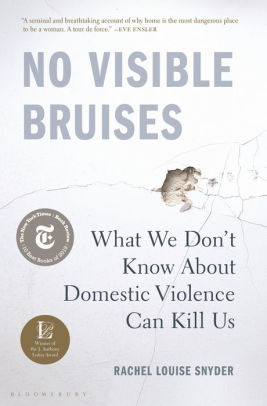Released May 2019
320 pages

It seems strange to discuss the entertainment value of a non-fiction book about domestic violence. Yet to discount the importance of reader engagement in non-fiction writing is to produce works about important subjects that will sit on the shelf. "No Visible Bruises" has an important message: domestic homicide can be predicted, and thus prevented, by noticing key signs. But author Rachel Louise Snyder uses storytelling throughout the book to show how these predictors play out with real lives at stake.
The book is told in three parts, and each section of the book has its own unique writing style. The beginning section uses narrative storytelling to convey a story of family annihilation that began as domestic abuse. Snyder doesn't bury the lead: from the beginning of the book, we know this family is going to be killed by its patriarch. And yet Snyder is able to give the reader such an intimate look at the victim that by the time the section is over, although she's already told us how the story ends, the reader cannot help but be devastated by the loss.
Beyond the narrative storytelling, Snyder leans on a variety of experts to show the full picture of domestic violence today. The thread running throughout the entire book is the understanding that experts have ways to measure the likelihood that a domestic violence situation will turn into domestic homicide. From interviews with social workers, women's shelter operators, and law enforcement, we are shown what can happen when partnerships between these stakeholders are forged. Women's lives can be saved by educating and empowering those in positions to notice the signs of future domestic homicide. Snyder also shows what happens when these partnerships don't exist, and how the result is often fatal.
One of the most interesting and difficult subjects tackled in this book is that of rehabilitation. Snyder follows several men in prison for domestic violence, and enrolled in programs meant to end the cycle of violence. In the end there are no clear conclusions; experts aren't sure what, if anything, can be done to prevent abusers from committing acts of violence again. But Snyder highlights several efforts to do just that, and the men trying to curb their own violence have compelling stories themselves.
The consequences of this book are readers who will no longer be ignorant to the signs of domestic violence. Armed with the knowledge that there are ways to predict and prevent domestic homicide, readers of "No Visible Bruises" may become advocates themselves to protect women. I have found myself reading crime briefs in the newspaper about assault charges, and wondering if the victims' lives may be at risk. This book makes you look at the world with a renewed perspective.
This may be the best non-fiction book of 2019, and is a must-read. Read it to see what exemplary non-fiction looks like, but also read it to inform yourself of the signs of domestic violence and abuse. Read it to honor the lives of those lost to this violence, and for the hope of a safer future for others.
No comments:
Post a Comment